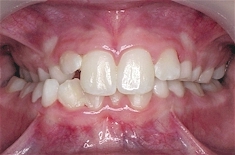Diagnosis
What is Orthodontics?
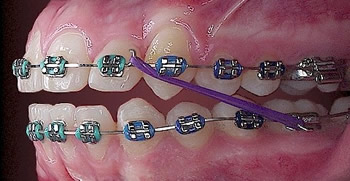 Orthodontics is that branch of dentistry which specialises in the diagnosis, prevention and treatment of problems in the alignment of teeth and jaws. The technical term for these problems is malocclusion, which literally means bad bite. Orthodontic treatment involves the design and use of corrective appliances (such as braces, plates, headgears and functional appliances) to bring the teeth and jaws into proper alignment.
Orthodontics is that branch of dentistry which specialises in the diagnosis, prevention and treatment of problems in the alignment of teeth and jaws. The technical term for these problems is malocclusion, which literally means bad bite. Orthodontic treatment involves the design and use of corrective appliances (such as braces, plates, headgears and functional appliances) to bring the teeth and jaws into proper alignment.
Why straighten teeth?
People have orthodontic treatment to improve the appearance, health and function of their teeth. Correcting your dental condition leads to not only a more attractive smile, but also better overall health. It's more difficult to clean your teeth when they are crowded and overlapping. Inadequate cleaning is a major factor in tooth decay, gum disease and eventual tooth loss. If you have problems with malocclusion, braces will help prevent future dental problems through minimizing stress on the gums and jaw. And finally, some people have difficulty speaking properly because of alignment problems with their teeth and jaws.
Your orthodontist can improve most tooth and jaw alignment problems at any age.
Adult orthodontic treatment:
Before treatment:
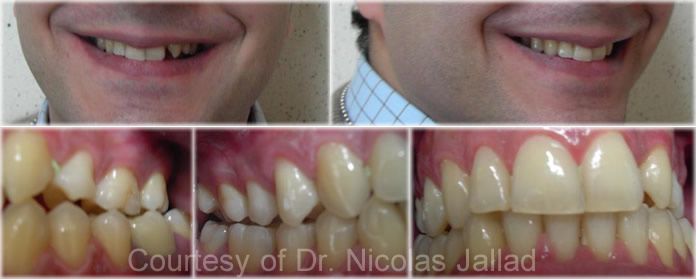
After treatment:

The American Association of Orthodontists recommends that children see an orthodontist no later than age seven. Orthodontic treatment involves the aligning, levelling, and coordination of both arches with braces. In growing patients, the bite is corrected with headgear, elastics or functional appliances. In severe cases, especially if growth is complete, jaw surgery might be required to correct the jaw disharmony.
Just look at Cameron Diaz. Can you remember a time when the Charlie's Angels star didn't light up the screen in every film she starred in? Well, a major contributor to her sex appeal is her beautiful smile. It wasn't, however, always like that for Cameron until she improved her smile with braces.
If you have any of the following, you may be a candidate for orthodontic treatment:
Crowded teeth:
A disharmony between tooth-size and jaw- size can result in crowded, irregular teeth. Crowded teeth can look unattractive and can be more difficult to clean. Orthodontic treatment usually involves the use of braces which are the most efficient and accurate way of aligning teeth. Sometimes it is necessary to extract teeth to provide sufficent space to allow the teeth to be aligned in a stable and harmonious positions within the jaws and face.
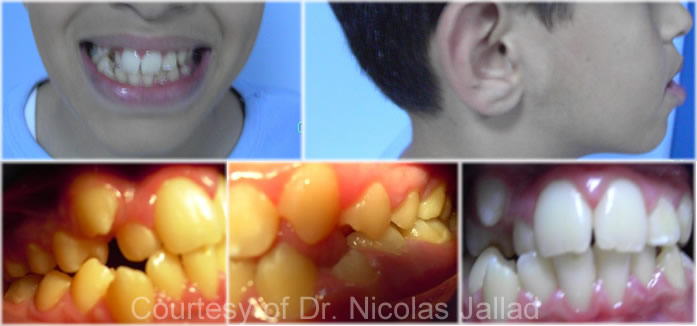
After
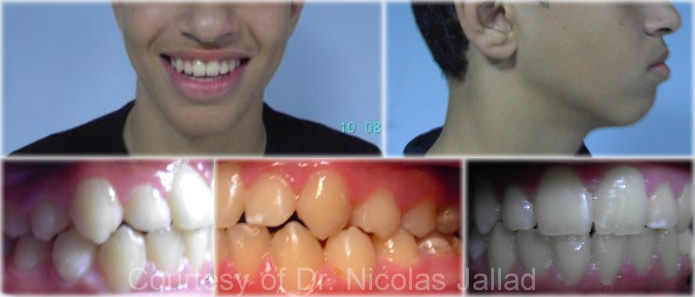
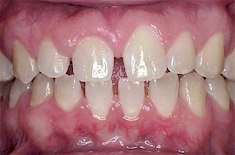 Spaced teeth:
Spaced teeth:
Spaces can result from a disharmony between tooth-size and jaw-size or by abnormal tongue thrusting activity. Spaces between the teeth can look unattractive and can interfere with speech. Orthodontic treatment usually involves the use of braces to align the teeth and to close the spaces. Abnormal tongue activity must be eliminated or the spacing is likely to recur.
Protruded teeth:
Protruded teeth result when the position of the upper jaw is forward of the lower jaw. In severe cases, the lower lip may sit behind the upper front teeth and push them further forward to accentuate the disharmony. Protruded teeth can be unattractive and prone to accidental damage. Often teeth become worn unevenly. Sometimes, the lower front teeth can over-erupt and damage the gum behind the top front teeth.

Under-bite:
When the lower jaw is forward in relation to the upper jaw, the lower front teeth protrude beyond the upper teeth and an "under-bite" result. An under bite can be unattractive and can cause uneven wear of the front teeth and jaw joint problems. In mild cases, conventional orthodontic treatment with braces, elastics, and reverse- pull headgear can be used to correct the problem. In more severe cases, jaw surgery is required to correct the bite and to create a more harmonious facial profile.
Early Treatment of Class 3:
Before treatment:

After treatment:

Deep-bite:
The upper and/or lower front teeth can overupt to produce a deep bite. In severe cases, the upper teeth can cover the lower teeth completely. A deep bite can cause excessive wear of the front teeth and can damage the gum behind the upper front teeth. Deep bites can exert excessive strain on the jaw joint resulting in temporomandibular joint problems.
Deep bite correction, Laser gummy smie treatment, and Lumineers placement on the 2 upper lateral incisors:
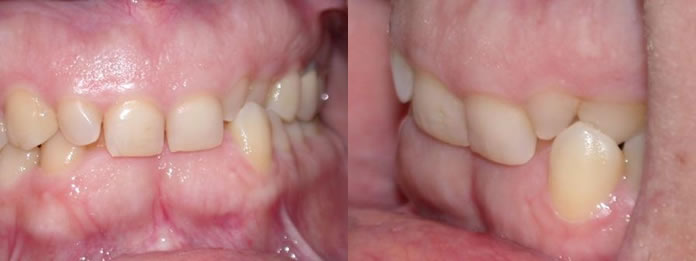

 Open-bite:
Open-bite:
An open-bite exists when opposing teeth don't meet. An open-bite can cause eating problems and excessive wear of those teeth which do make contact. An open-bite can be unattractive and can be associated with speech problems. Open-bites are often caused by abnormal tongue habits and, although the open-bite can be closed with braces, unless the abnormal tongue habits are corrected, the open bite is likely to recur.
Cross-bite:
The upper teeth should fit outside the lower teeth like a lid on a box. If the upper jaw is too narrow, the lower jaw usually swings to one side to allow the back teeth to mesh. A posterior cross-bite results. Posterior cross-bites can result in uneven wear of the teeth and can place extra strain on the jaw joint resulting in temporomandibular joint problems. Orthodontic treatment involves the use of a fixed or removable appliance to widen the upper jaw (maxillary expansion). Once the upper jaw has been widened, the lower jaw can close normally. Front teeth can also erupt in anterior cross-bite.
 Missing-teeth:
Missing-teeth:
Missing teeth can be unattractive. Opposing and adjacent teeth can drift into the space to create further problems. Orthodontic treatment involves moving all teeth into correct position, and creating proper space to facilitate replacement of the missing teeth.
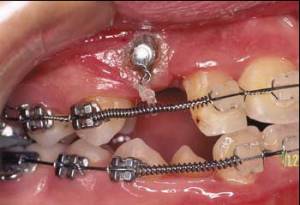 Impacted teeth:
Impacted teeth:
Impacted teeth don't have sufficient space to erupt. Orthodontic treatment involves creating space to allow the impacted tooth to erupt.
Ectopic teeth: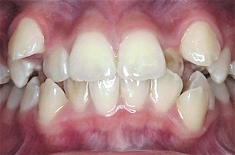
Ectopic teeth are teeth which develop in the wrong position. In most cases, ectopic tooth can be repositioned with braces. In this case, an ectopic canine (eye tooth) was surgically exposed and braces were used to move it into its correct position.
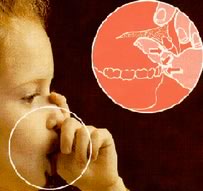 Thumb sucking:
Thumb sucking:
Sucking the thumb (or fingers) can produce a localised deformation of the teeth and supporting bone. Once the sucking habit has been stopped, as illustrated on the right, natural improvement can occur.
Other problems
An orthodontic opinion might also be sought when there is:
- Difficulty in chewing or biting
- Speech Difficulty
- Jaws that shift or make sounds
- Grinding or clenching of teeth
Conditions that increase the risk of orthodontic problems
There are some conditions or habits that increase significantly the risk of developing orthodontic problems. These include:
- Thumb sucking
- Finger sucking
- Pencil biting
- Early or late loss of baby teeth
Orthodontic Treatment
This section explains the various stages of a normal course of orthodontic treatment.
The first consultation:
During this visit the patient is examined clinically. This enables the orthodontist to give advice on the treatment options available, when treatment should commence, the duration of treatment, and the approximate cost. If the patient decides to proceed with treatment, an appointment is made to collect records.
Treatment Planning:
At this visit the orthodontist discusses the treatment plan(s) which have been formulated using information obtained from the first consultation and records. Then, arrangements are made to commence treatment or, if it is too early, to review the patient periodically until it is an appropriate time to commence treatment. Extractions and other preliminary procedures Sometimes it is necessary to remove teeth to gain sufficient space to align the remaining teeth. Any decayed teeth should be filled and the teeth sometimes need to be cleaned before orthodontic treatment is started. The patient is referred back to the family dentist to have these preliminary procedures carried out. The cost of these procedures is not included in the orthodontic fee.
How Long?
Orthodontic treatment usually takes 18 - 24 months. Some cases may be finished earlier and others may take longer to complete. The total treatment time depends on the severity of the original malocclusion, the type of treatment carried out, and the co-operation of the patient.
Dental check-ups:
Orthodontic patients should continue to attend their family dentist for regular check-ups during the course of orthodontic treatment.
Retention:
At the completion of the active part of orthodontic treatment, the braces are removed and retaining appliances (retainers) are fitted to hold the teeth steady in their new position. These appliances may be removable plates or wires fitted behind the teeth. Retainers play an important role in orthodontic treatment for, if they are not worn according to instructions, the teeth may move back towards their original position. The retaining appliances are usually worn: Full-time for up to one year. Just at night for a further year.
- Full-time for up to one year
- Just at night for a further year
- Phased out altogether over one more years

The corrected teeth are observed periodically for up to five years after the retainers have been phased out. During retention and the subsequent observation period, patients are expected to attend once or twice a year
